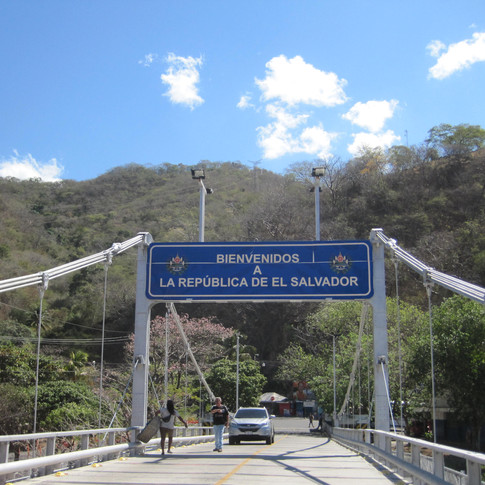El Salvador: Hola Hola Hola
- Yvonne O'Connor
- Apr 10, 2019
- 5 min read
Updated: Apr 24, 2019
We left Antigua early and after hitting fog in Guatemala City we said goodbye to Danilo. After that it was an easy ride to El Salvador. We crossed at the Valle Nuevo / Las Chinamas border and drove over the bridge linking the two countries. Families with kids were swimming in the river below. The El Salvador side was quiet, hot and dusty. All we needed was Gary Cooper and a clock to strike high noon. There was a sleeping dog and a nice girl in uniform sitting outside the little customs check-in shed. It was a long wait; the electricity had gone out and the computers and copier were dead. We watched as three guys crawled under a fold-up table and stared at one overloaded wall socket. Time stood still and the stall attendants dozed. Even if it hadn’t been a Sunday, it was a Sunday kind of day. At some point a nice man came out with a clipboard and inspected the bike and disappeared again. Two or three cars stopped just long enough to roll down their windows, then drive on and two backpackers had the customs lady take their picture on the bridge back to Guatemala.
Two hours later, the dog was still asleep but we had our bike permit. Immigration came next and lasted about three minutes with two officers under a pop-up canopy. No passport stamps. We carefully put the paperwork away only to be stopped at a police checkpoint a few yards up the road. He wanted passports and permit, never mind that we wouldn’t have got that far without them.....Still, what were we going to do, argue?
We’d been in touch with the El Salvador contingent of the motorcycle assist group before we left Guatemala. My contact was a Jimmy Garcia but he lived on the other side of the country near Honduras. He left me several messages but they were audio so I had to recruit Faustina my teacher to help translate. Even she had a hard time; people speak really fast down here. After playing about 8 times, I managed to get “Hola, hola, hola, todo bien, todo tranquilo” in response to my query about the safety of the roads. This was great news and I also learned how to greet someone correctly in El Salvador: Holaholahola.
The first thing we noticed was how clean the countryside was. No trash! The roads were well-surfaced too, and there were signs. Yes, signs! It wasn’t far to Ahuachapan but when we got to the hotel, my phone was lit up like a Christmas tree. Jimmy had found a friend here and he’d gone to the border to meet us. I was mortified and there followed a frantic exchange of texts. This was a perfect example of the constant threat of misunderstandings we’ve been operating under since Mexico. (Operating is the wrong word really as it implies a certain amount of planning and knowledge of what’s expected to happen.) We put it down to the culture gap. The members of our 'nanny' group take it for granted that they will look after their ‘guest’ (invited or not) from beginning to end. This can mean meeting them at the port of entry, providing entertainment during their stay and sometimes even dropping them off at the next border. It’s not always spoken, but it’s a given and as somebody once said, if you have to ask, you wouldn’t understand. We didn’t, so we don’t. So next time I’m going to bloody well ask.
Oscar was gracious when we finally did meet. To make up for our unintended rudeness, Fran gave him and his friends Ural rides around the plaza. Later on, as we sipped a great tasting cup of coffee at a street cafe, an extremely loud 3-man band started up. In spite of the caffeine, and the night sky trumpeting the very best of Latino music, we fell asleep early. It had been a very long day.
The following evening we met Aurelio, a friend of Danilo’s. He took us to Concepción de Ataco, a picturesque little town in the mountains. The streets were lined with artisan craft shops and colorful murals depicting the everyday life and rich culture of El Salvador. We kept out the evening chill by drinking a sweet, warm concoction laced with the liqueur of our choice from a mobile street bar. (What a great idea!)
When it came time to leave for the beach, Oscar insisted on driving with us. It took about 4 hours and as we meandered through curves that made Fran long for his old BMW, the sun shone on the fragrant, colorful foliage of the Ruta de Las Flores. Between villages the fields were emerald green and women walked tall with all sorts of produce and firewood on their heads, each load settled on a little piece of colorful cloth. I might practice with a tea towel one of these days and try to improve my posture. Apart from the surprise of a naked woman (well, she had panties) sitting on a sidewalk, it was a peaceful ride. As we got nearer to the coast, there were countless dark tunnels to be got through before we were blinded by our first views of the Pacific ocean.
El Tunco reminded me of Oaxaca’s Mazunte only quieter. With its young, hippy crowd, we felt a bit ancient. Fran hadn’t had time to grow hair and while I can’t remember when I last cut mine, I don’t know how to do dreadlocks. Still, I’d rather be old here than young in Florida. The near empty beach had black sand and a large expanse of smooth stones. Hostels and bars hung precariously from the cliffs, their haphazard terraces providing perfect front row sunset seating. We spent a lazy few days shuffling up and down the dusty street and stopping for hot pupusas with vinegary cabbage salad. These corn tortillas stuffed with beans, cheese or whatever meat is near at hand, were made to order while the cook’s child did his homework at a table in the corner. Of course we washed it all down with lashings of ice cold beer before collapsing by the pool. Our most energetic act was to buy $9.00 worth of Nicaraguan cordobas from a German couple heading north.
The last stop was San Miguel, only because it was within easy distance of the next border. We drove along the coast, passing the San Vicente volcano. The countryside was springtime personified with trees forming arches across the asphalt. San Miguel was a bit of a shock, not one ounce of beauty or charm. The people however had a gentle, friendly air and displayed amused indulgence at our fumbling attempts to order a quesadilla cake or other Salvadoran treat. As in Ahuachopan, we stood out as gringos but our foreignness felt welcomed and smiles on the street were always returned. We ate dinner on the side of the busy main road, inches from the mayhem of Saturday night traffic and wandering dogs skulking for crumbs. A walk to the city center revealed empty, shabby and somewhat gritty streets but there was a happy crowd and Sunday entertainment at the plaza. Pharmacies, restaurants, stationary and convenience stores all had guards at the entrances, each armed with long 12 gauge pump-action shotguns. They didn’t bother with uniforms. Once I got past the weapons, it was easy to smile in thanks when they opened doors for us and after a while, God forbid, it even became normal.
El Salvador has its problems with poverty, low economic growth and violence. We only saw evidence of the first two. We did not visit San Salvador and no doubt it and other urban areas have sides to them we would not care to see. We experienced only one layer of many in this small but beautiful country and we liked every bit of it. We felt privileged to be there and short-changed because we couldn’t stay longer. Jimmy Garcia was right. For us, everything was tranquilo and as we said goodbye, we’d much rather have been saying hello.














































Comments